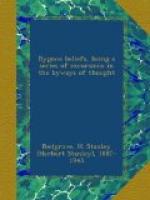PARACELSUS’ views were based upon his theory (undoubtedly true in a sense) that man is a microcosm, a world in miniature.[1] Now, all things material, taught PARACELSUS, contain the three principles termed in alchemistic phraseology salt, sulphur, and mercury. This is true, therefore, of man: the healthy body, he argued, is a sort of chemical compound in which these three principles are harmoniously blended (as in the Macrocosm) in due proportion, whilst disease is due to a preponderance of one principle, fevers, for example, being the result of an excess of sulphur (i.e. the fiery principle), etc. PARACELSUS, although his theory was not so different from that of GALEN, whose views he denounced, was thus led to seek for CHEMICAL remedies, containing these principles in varying proportions; he was not content with medicinal herbs and minerals in their crude state, but attempted to extract their effective essences; indeed, he maintained that the preparation of new and better drugs is the chief business of chemistry.
[1] See the “Note on the Paracelsian Doctrine of the Microcosm” below.
This theory of disease and of the efficacy of drugs was complicated by many fantastic additions;[1] thus there is the “Archaeus,” a sort of benevolent demon, supposed by PARACELSUS to look after all the unconscious functions of the bodily organism, who has to be taken into account. PARACELSUS also held the Doctrine of Signatures, according to which the medicinal value of plants and minerals is indicated by their external form, or by some sign impressed upon them by the operation of the stars. A very old example of this belief is to be found in the use of mandrake (whose roots resemble the human form) by the Hebrews and Greeks as a cure for sterility; or, to give an instance which is still accredited by some, the use of eye-bright (Euphrasia officinalis, L., a plant with a black pupil-like spot in its corolla) for complaints of the eyes.[2] Allied to this doctrine are such beliefs, once held, as that the lungs of foxes are good for bronchial troubles, or that the heart of a lion will endow one with courage; as CORNELIUS AGRIPPA put it, “It is well known amongst physicians that brain helps the brain, and lungs the lungs."[3]




